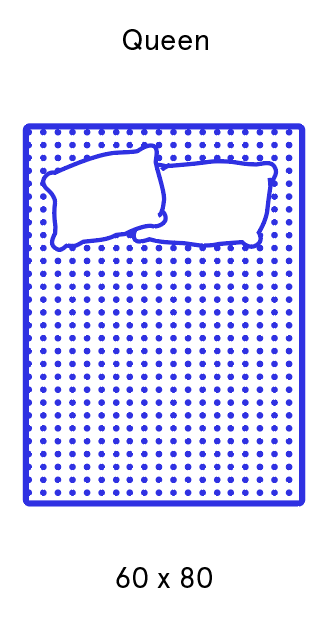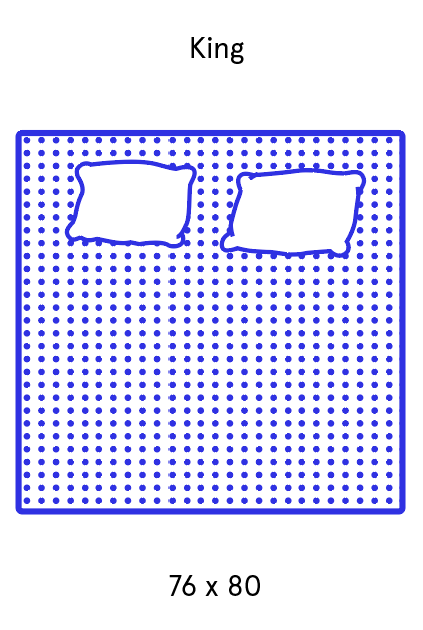Queen Mattress vs. King Mattress
Quick Overview
When choosing a mattress size, shoppers should take several factors into consideration. These include room size, budget, and the number of sleepers who plan to utilize the mattress. Most mattress models are available in six sizes: Twin, Twin Extra Long (Twin XL), Full, Queen, King, and California King. Other specialty and custom sizes may be available for certain models, as well.
This guide will compare two of the largest standard mattress sizes, Queen and King. To begin, let’s look at some basic differences between the Queen and King sizes.
Key Differences and Similarities between Queen and King Sizes
The table below highlights important distinctions between the Queen and King mattress sizes.
| Mattress Size | Queen | King |
| Standard width | 60 in. | 76 in. |
| Standard length | 80 in. | 80 in. |
| Ideal bedroom size | Minimum: 9 ft. wide x 11 ft. long | Minimum: 11 ft. wide x 11 ft. long |
| Average price range | $800 to $1,200 | $1,000 to $1,700 |
| Ideal sleep arrangement | Single sleeper who prefers abundant space or couples that do not require much extra space. | Couples who prefer abundant space, particularly those with children and/or pets that sometimes sleep with them. |
Pros and Cons of a Queen Size
 Queen-size mattresses account for roughly 40% of all mattress sales, making them the most popular size. As a result, the Queen-size mattress is an industry standard; many brands advertise their models using the Queen as a default reference point.
Queen-size mattresses account for roughly 40% of all mattress sales, making them the most popular size. As a result, the Queen-size mattress is an industry standard; many brands advertise their models using the Queen as a default reference point.
Benefits of a Queen-size mattress include the following:
- Less space required: A standard Queen-size mattress measures sixty inches (60″) wide and eighty inches (80″) long. They are suitable for any bedroom that measures at least nine feet (9′) wide and eleven feet (11′) long.
- Lower price-point: Though price differences vary by manufacturer, a Queen-size mattress may be priced $100 to $500 lower than a King-size version of the same model. The average Queen-size mattress costs between $800 and $1,200, though this varies by brand, model, and mattress type.
- Happy medium: For many sleepers, a Queen is the ideal size because it offers a wider and longer sleep surface than Twin or Full models, but does not take up as much space as a King or California King.
- Wide availability: With very few exceptions, every mattress model sold today is available in a Queen-size design.
- Lighter and easier to move: The average Queen-size mattress weighs between 80 and 100 pounds, making them relatively easy to move without assistance compared to King-size models. For this reason, a Queen-size mattress may be suitable for owners who frequently reconfigure their bedroom arrangements.
Drawbacks of Queen-size mattresses include the following:
- May not be couple-friendly: Although couples may be content with a Queen-size mattress, the limited width may be too narrow for some, including those with small children that sometimes sleep with them.
- Too small for bigger rooms: While it is usually more suitable for smaller bedrooms than a King, the Queen-size may appear too small and less aesthetically pleasing in larger bedrooms.
- Too short for exceptionally tall people: Anyone who stands higher than six feet and four inches (6’4″) will be too tall for a Queen-size mattress.
Pros and Cons of a King Size

The King size – which measures seventy-six inches (76″) wide and eighty inches (80″) long – is technically the largest standard mattress size with a total area of 6,080 square inches. Many mistakenly believe the California King – which measures seventy-two inches (72″) wide and eighty-four feet (84″) long – is the largest mattress size, but the California King covers a total area of 6,048 square inches.
Benefits of a King-size mattress include the following;
- Ample space: A King-size mattress provides a wider sleep surface that is suitable for most couples with extra space to spare.
- Kid- and pet-friendly: A King-size mattress may be ideal for parents and/or pet owners whose children and/or animals occasionally sleep with them.
- Aesthetically pleasing: A King-size mattress almost forms a perfect square shape, and will balance most bedrooms provided there is adequate space.
- Wide availability: Like Queens, King-size mattresses are widely available; the vast majority of mattress models sold today are offered in this size.
Drawbacks of King-size mattresses include the following:
- Higher price-point: King-size mattresses are always more expensive than Queens; in most cases, King and California King sizes share the same price-point, while select brands will price the California King higher.
- More space required: A bedroom should measure at least eleven feet (11′) wide by eleven feet (11′) long in order to accommodate a King-size mattress, meaning that smaller rooms may not have enough space.
- Relatively heavy: The average King-size mattress weighs 110 to 140 pounds, making them extremely difficult to move and maneuver without assistance.
Is a Queen or King Size Right for You?
Deciding between a Queen or a King mattress is a huge personal decision and depends on many different factors. These factors include things like body type, co-sleepers, sleeping position and bedroom space. We’ve outlined all these factors below and discussed how they fit into the Queen vs. King decision.
Do you sleep alone or with a partner?
Whether you sleep with a partner or not is always going to inform your choice of mattress sizes. Queen and King mattresses are both designed for co-sleeping, but for some couples the extra space of a King is preferred.
If you like to have a little more breathing room between you and your partner, then a King-size mattress will provide you with that additional space to toss and turn throughout the night. Since a Queen-size mattress can be more intimate and snug, people who tend to stretch their limbs and take a large portion of the bed may find it’s just too small to get entirely comfortable.
If you’re still unsure, we recommend that you and your co-sleeper test a few mattresses out first and see if you both feel comfortable on your half of the bed.
What is your body type?
Body type can play a large role in selecting your ideal mattress size. As a single sleeper, a Queen will likely be sufficient regardless of how wide or tall you are. While a Queen-size bed is usually sufficient for sleeping two average weight adults, a King might be necessary for couples on the heavier side.
Do children and/or pets frequently share your bed?
If your bed is home to the entire clan come weekend mornings, a King-size mattress may be a necessity. Pets, children, and your sleeping partner can all get comfortable and sprawl out on a King-size mattress for movietime or family bonding.
If you co-sleep with your children, a King-size bed will ensure you and your partner aren’t feeling like sardines while you share your sleeping space with your kids. When deciding between a Queen and King mattress, children and pets are often the determining factor.
How do you position your body when you sleep?
Sleep positions can play a large role in determining the best mattress size for you and your partner. Side, back and stomach sleepers all take up different amounts of space based on how they position themselves. If you’re a back sleeper that likes to sprawl out over the bed, you may need a bigger mattress than a side sleeper that keeps a straight profile. Consider how much space your sleeping position takes up and decide your size needs accordingly.
How much bedroom space do you have?
One of the largest factors in choosing between a King and Queen mattress is bedroom space. A King-size bed can overpower a small bedroom and make it difficult to decorate with other furnishings such as dressers and nightstands. If you plan on moving anytime in the near future, having a King-size bed will definitely limit your bedroom options when looking at new places. If you have a nice spacious master bedroom, however, then a King bed likely won’t be an issue.
What is your mattress shopping budget?
Lastly, consider your budget. You can save several hundred dollars by opting for the smaller size Queen mattress option. If you simply must have a larger bed, we recommend you shop during one of many online sales events or check out our guide on the best mattresses for the money.
Conclusion
Ultimately, a Queen-size mattress is most suitable for individual sleepers who prefer some extra space and couples who don’t mind a narrower fit. A King-size mattress, on the other hand, is ideal for couples who prefer extra space or who often have kids and/or pets in the bed.
Nonetheless, this decision is ultimately subjective. If you are unsure which size will work best, we recommend trying out both sizes in mattress stores, as well as participating in sleep trials that allow you to sleep on Queen- and King-size mattresses for longer periods of time and return the model that is least satisfactory for you and, if applicable, your sleep partner.